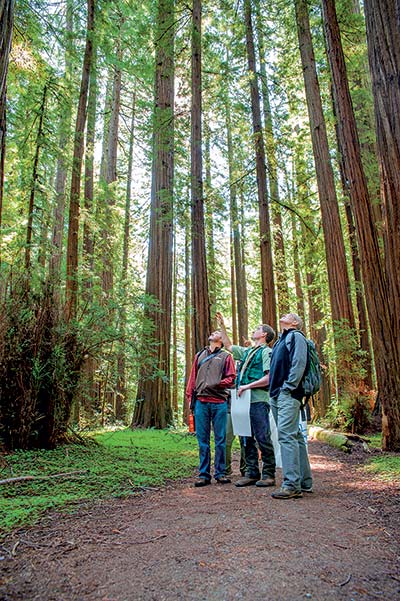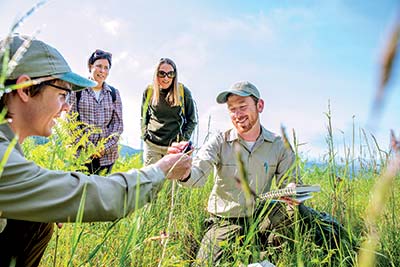Words can fail to describe the enormity of a redwood—the experience of standing at its base and looking up can leave you speechless.
But nonprofit Save the Redwoods League and Humboldt State researchers have plenty to say about the world’s largest and tallest trees, the giant sequoias and coast redwoods. Both institutions have been working together to uncover the mysteries of these giants in order to protect and restore them. These efforts are imperative in the “Year of the Redwoods,” declared for 2018 by the California State Senate, and “California Redwoods Month,” designated for October 2018 by California Gov. Jerry Brown.
“It’s critical to have experts willing to give their personal and professional time to make sure the research we’re pursuing is top notch,” says Emily Burns, science director at Save the Redwoods League, which is celebrating its centennial this year. “We love our partnership with Humboldt State on the North Coast. It feels like we’re all rowing in the same direction and bringing our complementary expertise for the same goal.” It’s a partnership that spans several League-funded HSU studies over the years, giving students, faculty, and alumni unique research opportunities that have advanced our understanding of redwoods.
Redwoods are big and can be very old—some date back over 3,000 years. But the coast redwood and giant sequoia are also astounding for lesser-known reasons. Their crowns are home to entire ecosystems and their thick bark makes them highly fire resistant. But a League-funded study that involves Humboldt State researchers has uncovered even more amazing attributes.
The most comprehensive study of redwoods ever, the three-phase Redwoods and Climate Change Initiative (RCCI) examines the impacts of climate change on redwoods. The RCCI began with a focus on old-growth forests that have been standing since before settlers first began logging in the 1850s.
In 2009, scientists from HSU (Forestry Professor Steve Sillett, researcher Allyson Carroll, and former lecturer Robert Van Pelt), UC Berkeley, and other institutions established 16 plots in old-growth forests—11 in the coast redwood geographic range from Del Norte to Monterey counties, and five in a giant sequoia forest in the Sierra Nevada.
To examine the amount of wood and biomass redwoods produced, the team measured many trees of all sizes, mapping main trunks and branches, and calculating quantities of leaves, bark, cambium, sapwood, heartwood, and dead wood. They collected core samples from trunks at all heights to determine tree ages and to quantify growth. They also surveyed surrounding vegetation, such as logs (standing and downed), shrubs, ferns, and herbs, and installed microclimate monitoring systems in a few plots to observe local weather and long-term climate.
In phase two, the team returned to each plot five years later, re-measuring the same trees and collecting core samples in the trunks of the trees they had climbed initially. In total, they mapped nearly 20,000 branches of coast redwood and giant sequoia and collected 1,462 core samples from 137 trees.
They found redwoods aren’t just doing well—they’re flourishing. According to initial results released in 2013, redwoods in several locations have grown at an accelerated pace since the 1970s. Scientists point to a few possible reasons: a longer growing season due to environmental changes; less fog, which means more sunlight; and an increase of carbon dioxide in the air. They also discovered that old-growth coast redwood forests store nearly three times more carbon than any other forests in the world.
With phase three now underway, Sillett and others are assessing how quickly redwoods reach a certain height while looking at variables such as elevation, distance from the ocean, rainfall, and drought. The study includes forests that have been previously logged, referred to as “second growth.”
Researchers are already coming across examples of redwoods’ resilience. Sillett explains what they found in a preserve burned in last year’s Sonoma County fires.
“Most of the Douglas fir and oaks were dead, the vegetation and shrubs were vaporized and the soil was reduced to ash. The redwoods were severely burned but didn’t care. They were green and sprouting,” he says.
Sillett, considered the world’s foremost expert on redwoods, has studied them for more than 20 years. Even so, the behemoths never cease to amaze him. “Whenever you walk into one of these forests you become overwhelmed,” he says. “We are but a mote of dust beneath innumerable stars. And upon the surface of the earth, these great vegetative beings stand, reminding us not to get too full of ourselves.”
This same sense of wonder led to the birth of Save the Redwoods League.
During a drive to Northern California in 1917, conservationists John C. Merriam, Henry Fairfield Osborn, and Madison Grant saw firsthand the magnificence of redwoods—and primeval forests logged into barren landscapes. They formed the League a year later and since then, the organization has protected more than 200,000 acres of redwood forest with the help of several conservation groups and activists.
One of those activists was the “Mother of Redwood National Park,” Lucille Vinyard. The Humboldt County environmentalist, who helped found the North Group of the Sierra Club’s Redwood Chapter in 1964.
Efforts by Vinyard, the League, and others helped establish Redwood National Park in 1968. Fifty years later, the federally protected park, along with three redwood state parks, form Redwood National and State Parks, which houses 45 percent of the remaining protected old-growth coast redwoods in California.
With its first 100 years focused on conservation, the League enters its second century with an eye on restoration.
The League teamed up with the National Park Service and California State Parks for a project known as Redwoods Rising to restore redwood forests in previously logged areas of Redwood National and State Parks. The plan includes thinning dense stands of other trees to promote rapid growth of redwoods by reducing competition for sunlight and water. One restoration strategy for recovering logged forests may even include experimental pruning of crown and branch tips, a technique shown to help accelerate the development of redwood treetop structures that provide wildlife habitat.
Starting at the ground level are HSU students like Len Mazur. The Environmental Science & Management major and seven other students spent the last few months gathering baseline data through the League’s first Redwoods Rising summer apprenticeship.
Mazur spent a few days at Mill Creek Watershed, an area between Jedediah Smith and Del Norte Coast Redwoods State Parks, mapping and removing invasive plants and monitoring rare plant species.
The experience wasn’t exactly a walk in the park, with some days including arduous hikes to remote areas.
“But that’s part of the fun. We get access to remote places and have a chance to spend hours out in the most beautiful parts of the park,” Mazur says. “It’s hard work but at the end of the day we all feel a strong sense of accomplishment and worked toward something very positive.”
Apprentices were mentored and advised by Forestry Professors Lucy Kerhoulas and Erin Kelly, both of whom work closely with the League. Kerhoulas received League-funded research grants to study epiphyte diversity in Sitka spruce crowns and to monitor redwood forest health and vigor in various thinned sites. Kelly serves on the League’s Council, a group of 60 volunteer advisors that make recommendations to the League’s staff and board of directors on everything from fundraising and programs to deciding on the distribution of research grant funding.
At the same time, HSU alumni Andrew Slack (’16, Natural Resources) and Laura Lalemand (’18, Natural Resources) have been coordinating logistical support for Redwoods Rising and overseeing apprentices as the League’s first Forest Fellows.
The goal of the fellowship and apprenticeships is to foster a new generation of people who want to dedicate their careers to taking care of redwoods forests, says Burns.
“We’d love to see HSU students become resource professionals or redwood researchers. All are incredibly valuable pursuits that are going to help redwoods in the long term,” says Burns. “And HSU does such a great job in providing those career opportunities with its education and training.” Redwood conservation has come a long way and Burns remains optimistic about what’s ahead.
“It’s a good moment to step back and look at our collective accomplishments and the great partnerships that have helped make the League successful,” she says. “It’s also a good time to be thinking ambitiously about the future. For the next 100 years, with our partners’ expertise and energy, we will do even more for redwoods.”

“Whenever you walk into
one of these forests you
become overwhelmed.
We are but a mote of dust
beneath innumerable stars.
And upon the surface of
the earth, these great
vegetative beings stand, reminding us not to get
too full of ourselves.”
—Steve Sillett
Professor and Kenneth L. Fisher Chair of
Redwood Forest Ecology

HSU Forestry Professors Erin Kelly (back, left) and Lucy Kerhoulas (back, right) observe students Ryan Thompson (front left) and Len Mazur (front right) as they conduct rare plant surveys in Redwood National Park as part of their Redwoods Rising summer apprenticeship program.